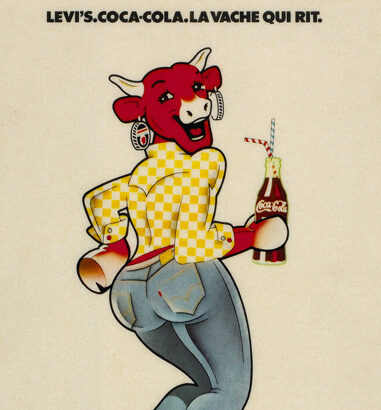Wait what, they turned the Laughing Cow into a sexy party girl? They sure did, look at how she is flirting with you. How else are they supposed to sell their unremarkable cheese? La Vache Qui Rit’s soft, crustless, processed white cheese is new and exciting in the 1920s, but loses its innovative nature as processed food becomes normal over time. And if you want to sell this cheese to the rebellious French youth of the late 1960s and 1970s, you will have to put out.
Barricades on fire
France, May 1968. Cobblestones soar through the air, barricades are blocking streets and the French government fears its downfall. French students have unleashed a powerful anger. They are outraged by the Vietnam War in France’s former colony. Students challenge capitalism, consumerism and the bourgeois lifestyle of the older generations as well. They resist a conventional family life of working, consuming and obeying. They want to liberate themselves from conservative expectations about relationships, sex, food, music, clothing, education, religion and authority. Students occupy their universities. Now, they cannot be ignored.
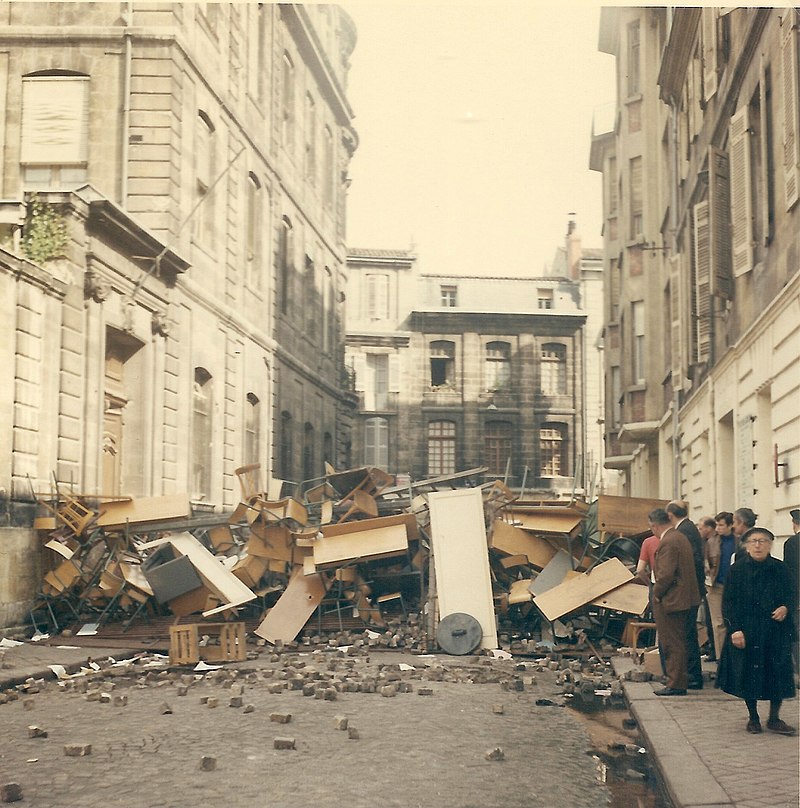
The protests start at the beginning of May and escalate quickly. On May 10th, nicknamed the Night of the Barricades, the situation explodes. Protests in Paris are struck down so violently by the riot police that it causes national outrage. According to the Smithsonian Magazine, 500 people are arrested, hundreds are injured and 11 million workers join the strikes and protests. The government even employs the army to control the uprising. Historian Julian Bourg states that the movement turns into a political crisis that is so severe that it still holds a prominent place in French collective memory.
From war symbol to French icon
In the eyes of an anti-capitalist, La Vache Qui Rit belongs with the status quo. The company starts out as a family business in the rural Jura area near Switzerland, according to the website of La Maison de La Vache Qui Rit. Founder Léon Bel (1878-1957) serves as a soldier in the First World War. During the war, the symbol of a smiling ox is drawn by illustrator Benjamin Rabier as the informal ‘badge’ of an army unit. In 1921, Bel founds La Vache Qui Rit. The cheese is sold in a tin package with a smiling silver cow. The cheese has a long-shelf life due to its processed nature, which is a new Swiss technology from 1917. The iconic red cow first appears in 1923, drawn by Rabier.
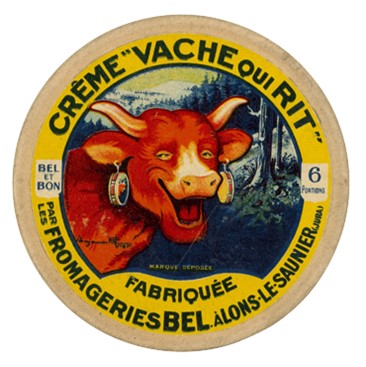
This package is the first one with the signature red Laughing Cow with round cheese earrings. The drawing was made by Benjamin Rabier. The background consists of a snowy, forested mountain hill that is typical for the Jura.
After the Second World War, La Vache Qui Rit grows into an international company that advertises all over France. On streets, in buses and movie theatres, on radio programmes – La Vache is everywhere. The cheese is often marketed towards children, but adults remain a target audience as well. Through it all, La Vache is always smiling, always red and always wearing her iconic cheese earrings. By the 1960s, La Vache Qui Rit has become an international company that thrives in the capitalist West. It is a large French brand that sells soft white cheese to French families. None of that is likely to appeal to the anti-conventional rebellious French youth.
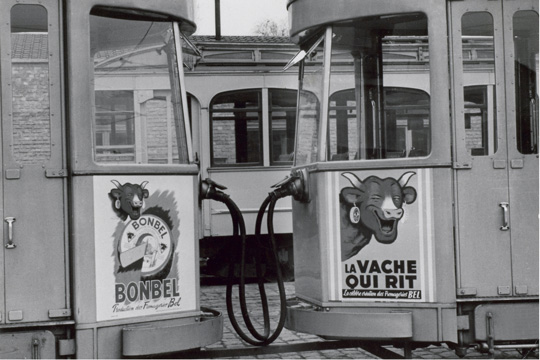
Through advertisement on the street, for instance on public transport as pictured above, La Vache Qui Rit was often visible in urban public spaces. The bright red colour of the cow must have made it even more of an eye catcher.
A make-over for La Vache
Like Bourg stated, the protests of 1968 change France for good. Even though the government remains intact, the mentality of the French people has changed. So in order to cash in French youngsters’ pocket money, La Vache needs a huge make-over. As a result an entirely new mascot appears in the 1970s. As you can see, La Vache is more feminine and she is younger. Her face and horns are rounder and her eyes are bigger. She becomes more human as well as she is clothed and accessorized. According to the museum, the goal of the new advertisements is to “create a dynamic and modern image of the Laughing Cow among younger consumers”. In doing so, they appeal to both a French hippie youth culture and a globally oriented youth culture.

The upper text translates as: “The cheese that goes anywhere with you.” The bottom text translates as: “The Laughing Cow. The cheese that deserves its fame.” The poster is entirely in the style and spirit of 1960s French youth: it combines cultural roots (cheese and clothing) with freedom (hitchhiking and guitar music).
In this poster, La Vache shows her roots through traditional clothing and the cheese, but also represents freedom of movement by hitchhiking with her backpack. This is emphasized by the upper text that says: “The cheese that goes anywhere with you”. Freedom of expression and culture is symbolized by the guitar. The slogan on the bottom says: “A cheese that deserves its fame”. This emphasizes that La Vache Qui Rit cheese isn’t just a good product because it always has been – which is the kind of rhetoric the youth dislikes – but that it actually deserves its reputation. The brand tries to connect to French youth by portraying their ideals and lifestyle. The museum claims that this advertisement embodies “the aspirations inherited from May 68”.
A second poster, presumably from the 1970s as well due to its design, aligns itself with global youth culture. Here we see a different La Vache. She wears modern clothes, like her tight Levi jeans, and drinks Coca Cola.
.
.
.
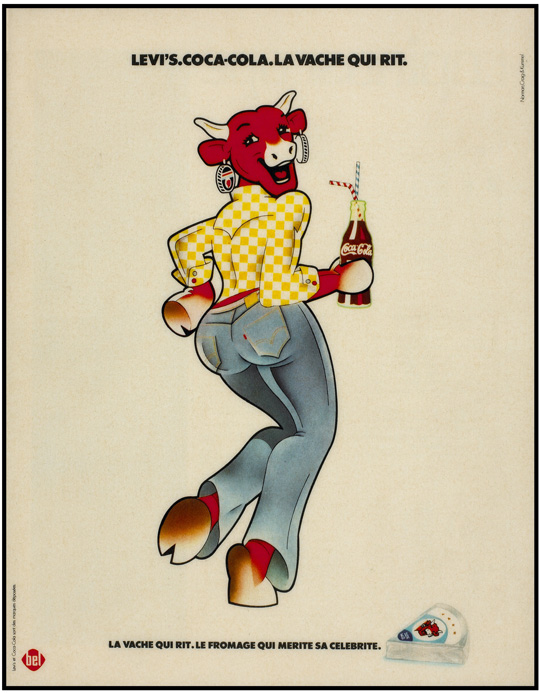
The text on the bottom translates as: “The Laughing Cow. The cheese that deserves its fame.” This advertisement shows the French youth that La Vache Qui Rit belongs in this modern world, which is emphasized by La Vache’s cheeky stance and smile, her tight Levi jeans and Coca Cola drink.
This may seem contradictory to the ideals of 1968, but as sociologist Rob Kroes has observed, ideals of freedom were often represented by American commodities such as cigarettes, jeans and soft drinks. Those items helped European youths to rebel and express an identity of their own. Now look at this poster, La Vache takes on a sexy pose with her jeans and soda. She is trendy and cosmopolitan. La Vache Qui Rit explicitly aligns itself with popular brands like Levi’s and Coca Cola. Brands that, according to Kroes, used sexually provocative advertisement in Europe and sent messages of pleasure and freedom that resonated with European youths. La Vache Qui Rit tries to prove to a younger audience that their product fits in with global youth culture and also carries those messages of pleasure and freedom they like to see in advertisements.
.
.
.
A sign of the times
So that’s how La Vache Qui Rit has tried to attract the French youth that briefly saw France turned upside down; by advertising with a flirty, cosmopolitan cow and a free-spirited hippie cow. A seemingly superficial and funny poster of a cow in tight jeans with a soda turns out to be a sign of the times. It tells a broader story about consumer culture and youth culture in 1960s and 1970s France. Did you expect that? How will you look at advertisements from now on?
Written by Jitske Hell
